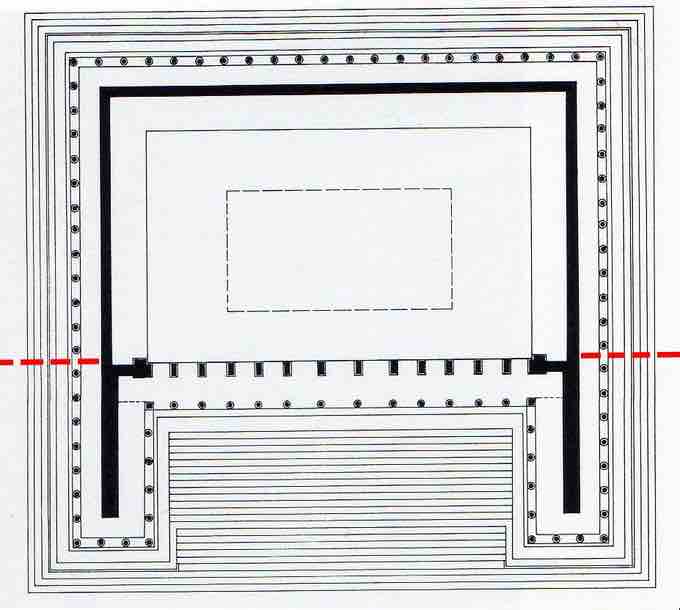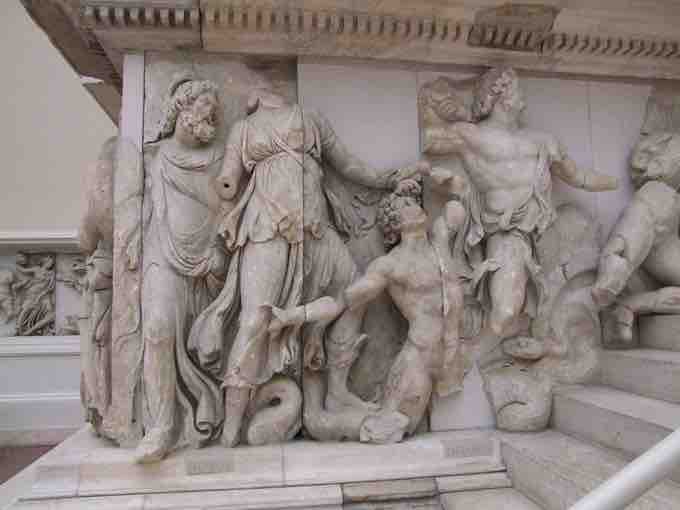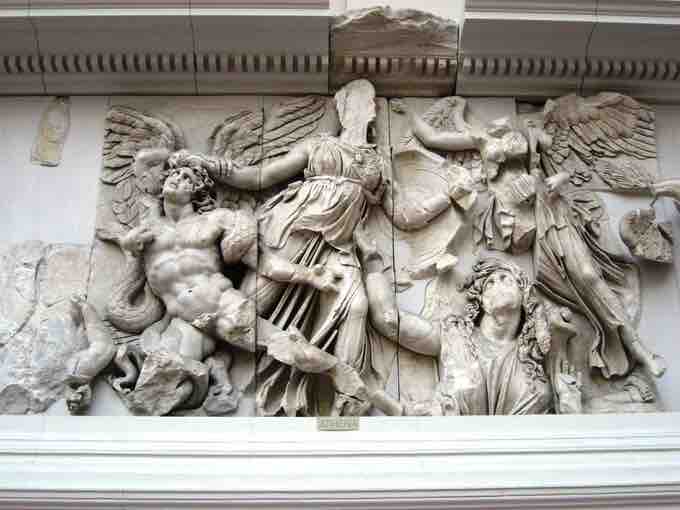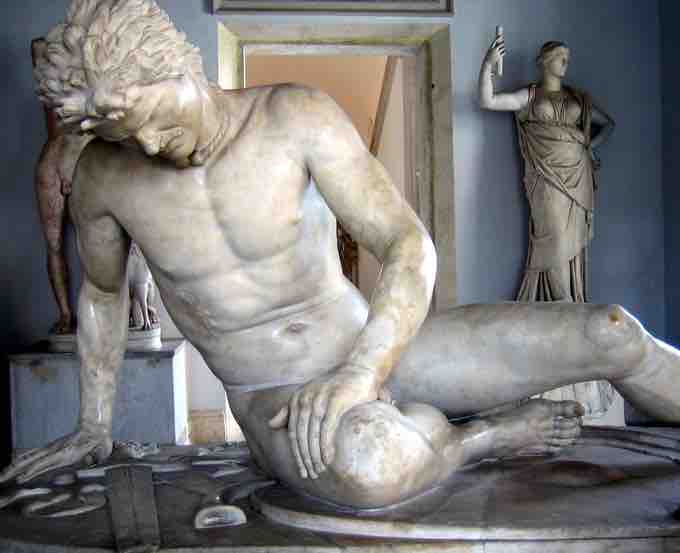The ancient city of Pergamon, now modern day Bergama in Turkey, was the capital of the Kingdom of Pergamon following the death of Alexander the Great and was ruled under the Attalid dynasty. The Acropolis of Pergamon is a prime example of Hellenistic architecture and the convergence of nature and architectural design to create dramatic and theatrical sites. The acropolis was built into and on top a steep hill that commands great views of the surrounding countryside. Both the upper and lower portions of the acropolis were home to many important structures of urban life, including gymnasiums, agorae, baths, libraries, a theater, shrines, temples, and altars.
Scale model of Pergamon as it might have looked in Antiquity.
Center left: Theatre of Pergamon. Center right: Altar of Zeus. Pergamon Museum, Berlin.
The theater at Pergamon could seat 10,000 people and was one of the steepest theaters in the ancient world. Like all Hellenic theaters, it was built into the hillside, which supported the structure and provided stadium seating that would have overlooked the ancient city and its surrounding countryside. The theater is one example of the creation and use of dramatic and theatrical architecture.
Theatre of Pergamon
Altar of Zeus
Another element found at Pergamon is the great Altar of Zeus (now housed in Germany). The altar was commissioned in the first half of the second century BCE during the reign of King Eumenes II to commemorate his victory over the Gauls, who were migrating into Asia Minor. The altar is a U-shaped Ionic building built on a high platform with central steps leading to the top. It faced east, was located near the theater of Pergamon, and commanded an outstanding view of the region. The altar is known for its grand design and for its frieze which wraps 370 feet around the base of the altar depicting gigantomachy.

Plan of the Altar of Zeus
c. 175 BCE. Bergama, Turkey.

Altar of Zeus
Marble. c. 175 BCE. Original from Bergama, Turkey now in Berlin, Germany.
The Gigantomacy
The gigantomachy depicts the Olympian gods fighting against their predecessors the Giants (Titans), the children of the goddess Gaia. The frieze is known for its incredibly high relief, in which the figures are barely restrained by the wall, and for its deep drilling of lines with details to create dramatic shadows. The high relief and deep drilling also increases the liveliness and naturalism of the scene. The figures are rendered with high plasticity. The texture of their skin, drapery, and scales add another level of naturalism. Furthermore, as the frieze follows the stairs, the limbs of the figures begin to spill out of their frame and onto the stairs, physically breaking into the space of the viewer. The style and high drama of the scenes is often referred to as the Hellenistic Baroque for its exaggerated motion, emphasis on details, and the liveliness of the characters.

Nereus, Doris, a Giant, and Oceanus.
Marble. c. 175 BCE. From the north frieze of the Altar of Zeus, Bergama, Turkey.
The most famous scene on the frieze depicts Athena fighting the giant Alkyoneus. She grabs his head and pulls it back while Gaia emerges from the ground to plead for her son's life and a winged Nike reaches over to crown Athena. Athena's drapery swirls around her with deep folds and her whole body is nearly removed from the frieze. The figures are depicted with the heightened emotion commonly found on Hellenistic statues. Alkyoneus's face strains in pain and Gaia's eyes, which are all that remain of her face, are full of terror and sorrow at the death of her son. The entire composition is depicted in a chiastic shape. Athena stretches out to grasps Alkoyneus's head, the two figures pull at each other in opposite directions. Meanwhile, the figure of Nike moves diagonally towards Athena, showing their convergence in a moment of victory. The diagonal line created by Gaia mimics the shape of her son, connecting the two figures through line and pathos. The scene is filled with the tension and emotion that are key features in Hellenistic sculpture.

Athena and Alkyoneos
Marble. c. 175 BCE. From east frieze of the Altar of Zeus, Bargama, Turkey.
The Dying Gauls
A group of statues depicting dying Gauls, the defeated enemies of the Attalids, were situated inside the Altar of Zeus. The original set of statues is believed to have been cast in bronze by the court sculptor Epigonus in 230-220 BCE. Now only marble Roman copies of the figures remain. Like the figures on the frieze and other Hellenistic sculptures, the figures are depicted with lifelike details and a high level of naturalism. They are also depicted in the common motif of barbarians. The men are nude and wear Celtic torcs. Their hair is shaggy and disheveled. The figures are positioned in dramatic compositions and are shown dying heroically, which turns them into worthy adversaries, increasing the perception of power of the Attalid dynasty. All three figures in the group are depicted in a Hellenistic manner. To fully appreciate the statues, it is best to walk around them. Their pain, nobility, and death are evident from all angles.
One Gaul is depicted lying down, supporting himself over his shield and a discarded trumpet. He furrows his brow as he looks downward at his bleeding chest wound as he prepares himself for death. His muscles are large and strong, signifying his strength as a warrior and implying the strength of the one who struck him down.

Epigonos. Dying Gaul
Roman marble copy of Greek bronze original c. 230-220 BCE. Pergamon, Turkey.
Two other figures complete the group. One figure depicts a Gallic chief committing suicide after he has killed his own wife. Also known as the Ludovisi Gaul, this sculpture group displays another heroic and noble deed of the foes, for typically women and children of the defeated would be murdered to avoid them from being captured and sold as slaves by the victors. The chief holds his fallen wife by the arm as he plunges his sword into his chest, where blood is already exiting the wound.
Epigonos. Ludovisi Gaul.
Roman marble copy of Greek bronze original c. 230-220 BCE. Pergamon, Turkey.